Magpie-lark
| Magpie-lark | |
|---|---|
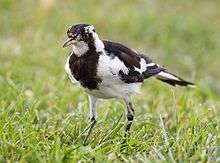 | |
| Female | |
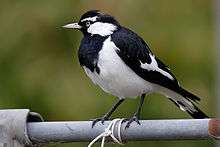 | |
| Male | |
| Scientific classification | |
| Kingdom: | Animalia |
| Phylum: | Chordata |
| Class: | Aves |
| Order: | Passeriformes |
| Family: | Monarchidae[2] |
| Genus: | Grallina |
| Species: | G. cyanoleuca |
| Binomial name | |
| Grallina cyanoleuca (Latham, 1801) | |
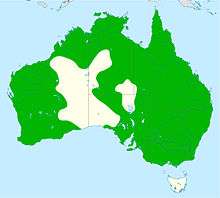 | |
| Distribution shown in green | |
The magpie-lark (Grallina cyanoleuca) is a conspicuous Australian bird of small to medium size, also known as the mudlark in Victoria and Western Australia, the Murray magpie in South Australia, and as the peewee in New South Wales and Queensland. It had been relegated to a subfamily of fantails in the family Dicruridae (drongos), but has been placed in a new family of Monarchidae (monarch flycatchers) since 2008.[2]
It is a common and very widespread bird both in urban and rural areas, occupying all parts of Australia except for Tasmania and some of the inland desert in the far north-west of Western Australia, and appears to have adapted well to the presence of humans. It is also found in southern New Guinea.
Taxonomy
The magpie-lark was originally described by the English ornithologist John Latham in 1801 and given the binomial name Corvus cyanoleucus.[3][4] Like many Australian birds, the English name was based on its apparent similarity to the northern Hemisphere birds familiar to European settlers. In fact, it is a magpie not a lark and is not particularly closely related to either—though its actual relationship to other birds remains uncertain: it was traditionally placed somewhere in-between the mud nest builders and the currawong family (both of which look rather similar) but, in the light of modern DNA studies, is now grouped with the monarch flycatchers.[5]
Two subspecies are recognised:[5]
- G. c. cyanoleuca - (Latham, 1801): found in western, central, eastern and southern Australia
- G. c. neglecta - Mathews, 1912: found in northern Australia
It has many common names, including peewit, peewee, mudlark (in Victoria), and Murray magpie. It was known as yilimbirraa among the Yindjibarndi people of the central and western Pilbara.[6]
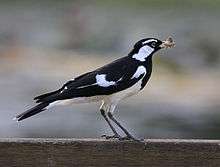
Description
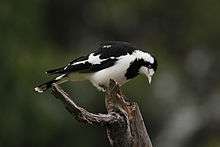
The magpie-lark is 25 to 30 cm (9.8 to 11.8 in) long when fully grown, or about the same size as a European common blackbird, and boldly pied in black and white; the weight range is 63.9 to 118 g (2.25 to 4.16 oz) for males, and 70 to 94.5 g (2.47 to 3.33 oz) for females.[7] They are a familiar sight around Australia; sitting on telephone wires either singly or in pairs, or patrolling patches of bare ground, especially foreshores or swamps. The sexes are similar from a distance but easy to tell apart: the female has a white throat, the male a black throat and a white "eyebrow". Juveniles and immatures of either sex have the white throat of the female and the black eyestripe of the male, and a white belly.
Behaviour
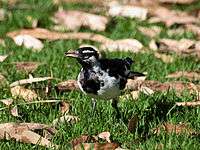
A primarily carnivorous species that eats all sorts of small creatures, the magpie-lark can adapt to an enormous range of different habitats, requiring only some soft, bare ground for foraging, a supply of mud for making a nest, and a tree to make it in. They have benefited greatly from agriculture: both the clearing of dense forest in fertile zones and the provision of artesian water in arid areas—although a disaster for other species—have been a boon for bare-ground and short-grass feeders like magpies and magpie-larks.
Group gatherings of magpie-larks have been observed, with loose "flocks" comprising dozens of individuals being observed perched on vantage points. Such behaviour is common, particularly in productive agricultural areas. This behaviour may be pairing or breeding related or simply indicate a bountiful feeding area.
The magpie-lark is aggressively territorial, and will fearlessly defend its territory against larger species such as magpies, ravens, kookaburras, and even the wedge-tailed eagle. They are also known to attack people to defend their nesting area.[lower-alpha 1][12] Although attacks on people are not as vicious as masked lapwings and magpies, they can still result in surprise or minor injury to the recipient.
Breeding

Birds generally pair for life (though divorce is not unknown) and defend a territory together. The nest is round, about 150 mm in diameter with vertical sides and is usually placed on a flat branch somewhere near water or on a horizontal beam of a telephone pole. It is made of grass and plant material thickly plastered together with mud, and generously lined with grass, feathers and fur. Breeding is opportunistic, usually from August to February in the fertile south, anytime after rain in drier areas, and multiple broods are common when conditions allow. Both parents incubate a clutch of between three and five eggs. Incubation of eggs takes up to eighteen days, and the young birds fledge about three weeks after hatching. It is quite common for only some of the chicks to survive because sometimes the nest is not big enough for all of the baby birds, therefore one baby will sometimes push another out of the nest and it is most likely that the chick will not survive the fall.
Duet singing
Magpie-larks are one of the 200-odd species of bird around the world that are known to sing in duet; each partner producing about one note a second, but a half-second apart, so that humans find it difficult to tell that there are actually two birds singing, not one.
Traditionally, it has been thought that the function of duet singing (not just in magpie-larks but birds more generally and indeed in mammals, insects and frogs) was to defend a territory or to maintain the pair-bond. More recently it has been proposed that it serves to guard against infidelity—that the male sings to attract a mate, and the female joins in to let her rivals know that this particular male is already taken. Duet singing remains fairly poorly understood as a great deal of the existing research on birdsong has been carried out in the northern Hemisphere, where a fairly small number of female birds sing.
In the case of the magpie-lark, the duet singing is now known to be cooperative: pairs sing together to defend their territory. Magpie-larks sing more vigorously in response to duet calls from other birds than they do to the call of a single rival, and more vigorously still if the callers are strangers rather than established and familiar birds from a neighbouring territory. A pair of neighbours calling from the 'wrong' place, however, (as when calls are recorded and played back by an experimenter) bring forth a powerful reaction: clearly, they know exactly who their neighbours are.[13]
 A male magpie-lark showing dorsal feather colouring.
A male magpie-lark showing dorsal feather colouring.

- A magpie-lark attacking a car mirror.
References
- ↑ BirdLife International (2012). "Grallina cyanoleuca". IUCN Red List of Threatened Species. Version 2013.2. International Union for Conservation of Nature. Retrieved 26 November 2013.
- 1 2 Christidis L, Boles WE (2008). Systematics and Taxonomy of Australian Birds. Canberra: CSIRO Publishing. p. 174. ISBN 978-0-643-06511-6. As cited here, the same authors had earlier treated the monarch flycatchers as a subfamily of the Dicruridae, as still does Museum Victoria.
- ↑ Mayr, E. (1962). "Family Granillidae, Australian mud nest builders". In Mayr, E.; Greenway, J.C. Jr. Check-list of birds of the world, Volume XV. Cambridge, Massachusetts: Museum of Comparative Zoology. p. 159.
- ↑ Latham, John (1801). Supplementum indicis ornithologici sive systematis ornithologiae (in Latin). London: G. Leigh and S. Sotheby. p. xxv.
- 1 2 Gill, Frank; Donsker, David (eds.). "Monarchs". World Bird List Version 5.4. International Ornithologists' Union. Retrieved 8 December 2015.
- ↑ Juluwarlu Aboriginal Corporation (2005). Garruragan: Yindjibarndi Fauna. Juluwarlu Aboriginal Corporation. p. 21. ISBN 1-875946-54-3.
- ↑ Tingay, A.; Tingay, S. (2009). "Magpie-lark (Grallina cyanoleuca)". In del Hoyo, J.; Elliott, A.; Sargatal, J.; Christie, D.A.; de Juana, E. Handbook of the Birds of the World Alive. Lynx Edicions. Retrieved 9 December 2015.(subscription required)
- ↑ http://www.trevorsbirding.com/larking-around/
- ↑ Joyce, Nikkii (8 June 2010). "Grumpy peewee attacks little girl". Sunshine Coast Daily. APN. Retrieved 30 August 2015.
- ↑ Mannix, Liam (8 July 2014). "Swooping bird attacks woman at Richmond train station". The Age. Fairfax Media. Retrieved 30 August 2015.
- ↑ Billias, Maria (5 June 2015). "Swooping bird attacks glamour girls in Mitchell St frenzy". NT News. News Corp. Retrieved 30 August 2015.
- ↑ http://www.dpi.wa.gov.au/mediaFiles/cycling_factsheets_birds.pdf archived at http://web.archive.org/web/20110330064540/https://www.dpi.wa.gov.au/mediaFiles/cycling_factsheets_birds.pdf
- ↑ "No larking matter: a duet's dire precision", Richard Macey, June 5, 2007, The Sydney Morning Herald
External links
| Wikimedia Commons has media related to Magpie-lark. |
| Wikispecies has information related to: Grallina cyanoleuca |
- Magpie-lark videos, photos & sounds on the Internet Bird Collection
